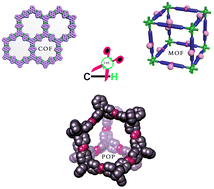Metal–organic framework (MOF)-, covalent-organic framework (COF)-, and porous-organic polymers (POP)-catalyzed selective C–H bond activation and functionalization reactions
Abstract
Although C–H functionalization is one of the simplest reactions, it requires the use of highly active and selective catalysts. Recently, C–H-active transformations using porous materials such as crystalline metal-organic frameworks (MOFs) and covalent-organic frameworks (COFs) as well as amorphous porous-organic polymers (POPs) as new emerging heterogeneous catalysts have attracted significant attention due to their promising activity and potential material tunability. These porous solids offer exceptional structural uniformity, facile tunability and permanent porosity. In addition, tuning the catalytic selectivity of these porous materials can be achieved through engineering their site microenvironments, such as metal node substitution, linker changes, node/linker functionalization, and pore modification. The present review provides an overview of the current state of the art on MOFs, COFs and POPs as advanced catalysts for various C–H bond activation reactions, providing details about their chemo-, regio-, and stereo-selectivity control, comparing their performance with that of other catalysts, triggering additional research by showing the present limitations and challenges in this area, and providing a perspective for future developments.



 Please wait while we load your content...
Please wait while we load your content...